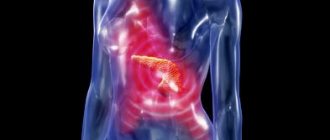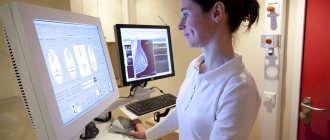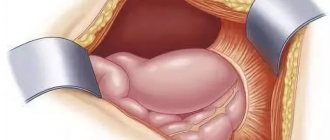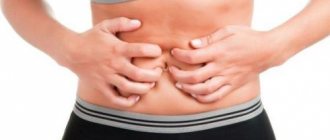Stomach pain above the navel, what is it? There may be different reasons. The stomach and upper part of the duodenum are located in this area, so any pain requires the most careful attention and referral to a specialist.
The pain can be sharp, cutting, aching, it can appear once or occur constantly. Since they indicate various pathologies, if your stomach hurts above the navel, you should definitely consult a gastroenterologist and undergo a full examination.
Causes of pain
The cause of pain may be acute gastritis.
Pain in the area above the navel can be an alarming sign of acute or chronic disease in various parts of the digestive tract.
As a rule, its appearance indicates the presence of the following pathologies and inflammatory processes:
- Acute gastritis is an inflammation of the stomach that occurs as a result of the activity of the Helicobacter pylori bacterium and disruption of the normal diet. Abdominal pain is accompanied by nausea, vomiting, diarrhea, and a gray coating appears on the tongue. The disease requires both drug treatment and a special diet to prevent it from becoming chronic.
- Cancerous tumors of the stomach. This is the most dangerous condition; cancer remains one of the key causes of death worldwide. In the initial stages, cancer is curable: the first sign is persistent nagging pain at the site of the tumor, in addition, symptoms of gastritis, a feeling of fullness, and a sharp decrease in appetite and weight loss are observed.
- Peptic ulcer of the stomach and duodenum. Pain usually appears in the morning, and it can also occur with long gaps between meals. Often they are so strong that the patient has to get up at night to drink an analgesic or eat, and after eating the pain disappears.
- Pancreatitis is inflammation of the pancreas. If the inflammation affects the head of the gland, then the pain will be localized on the right in the upper abdomen, and with inflammation in the central part, the pain will appear above the navel. The disease is also manifested by indigestion, diarrhea, and the appearance of mucus particles in the stool.
- Duodenitis is an inflammatory process in the duodenum. Pain appears in the epigastric region, especially noticeable with pressure. Patients experience a decrease in apatite, and after eating they may experience a feeling of nausea.
The most dangerous condition, which can manifest itself as pain in the area above the navel, is appendicitis - inflammation of the appendix of the intestine. In this case, pain first occurs in the middle part of the abdomen, and then it moves to the right and down. Tension of the abdominal muscles occurs, the pain intensifies with movements.
If you suspect appendicitis, you should urgently call an ambulance.
When to see a doctor?
The following conditions require emergency medical care:
- acute pain of high intensity, which cannot be relieved with antispasmodics and painkillers;
- pain syndrome, which is accompanied by a violation of the general condition (loss of consciousness, drop in pressure, fever, severe weakness, shortness of breath, pale skin);
- violation of the passage of intestinal gases and stools;
- urinary disorders;
- signs of gastrointestinal bleeding (vomiting with blood, resembling coffee grounds, black tarry stools).
In such situations, you need to call an ambulance or go to the emergency department of the on-duty surgical hospital yourself. You should contact a clinician or gastroenterologist in the following situations:
- pain appears regularly after eating or under other circumstances;
- pain is accompanied by nausea, vomiting, stool upset, fever, heartburn;
- attacks of pain have already occurred several times for no apparent reason.
In children, abdominal pain syndrome has distinctive features, and the indications for seeking medical help are also different.
Such signs indicate the development of conditions that require immediate surgical intervention. Particular attention should be paid to pain above the navel in pregnant women, children or the elderly (even in the absence of threatening symptoms) - any pathologies in such patients develop very quickly and can lead to dire consequences.
In the above cases, before the medical team arrives, you should not give the person any medications, as they can blur the clinical picture, and you should also refrain from eating, enemas, applying ice or a heating pad to the stomach, so as not to worsen the patient’s condition.
Why does the stomach hurt in children?
Pain in children occurs due to lactose intolerance.
The appearance of abdominal pain in the navel area is not always a sign of a serious inflammatory process. They can also be the result of a digestive disorder, which occurs especially often in children.
As the digestive system continues to develop, any deviation from the diet or consumption of unusual foods can cause pain, nausea and bowel movements.
In young children, abdominal pain often occurs due to lactose intolerance. During the digestion process, it is broken down by a special enzyme - lactase.
How is the disease diagnosed?
Diagnosing diseases in patients who come with complaints of pain above the navel is a difficult task even for an experienced doctor. After all, the description and sensation of pain is a very subjective thing; many sick patients simply limit themselves to describing their condition as “some kind of strange pain.” To identify a specific disease, you need to undergo a number of examinations, in particular:
- general clinical blood test;
- Magnetic resonance imaging;
- Ultrasound of the abdominal organs;
- CT scan;
- biopsy of the digestive tract;
- gastroscopy;
- HP-metry method;
- cytological studies.
Of course, it is not a fact that you will have to go through all the above procedures. In different cases, diagnosis can be simple, or, on the contrary, complex and lengthy. Treatment of abdominal pain above the navel is, in fact, therapy for the disease or pathology that caused it.
Pain in the navel area due to diseases of the small intestine
Pain can be associated with very dangerous conditions that threaten the patient’s life.
Very often, pain near the navel occurs due to diseases of the small intestine: they occur both above the navel and in the area below it, depending on the existing pathology.
Pain can be associated with very dangerous conditions that threaten the patient’s life.
Cramping pain appears around the navel with obstruction of the small intestine - it occurs under the influence of mechanical reasons, or when compressed due to adhesions or volvulus. Severe pain is accompanied by repeated vomiting; it does not lead to improvement.
There is no gas or diarrhea. If measures are not taken in a timely manner, the pain may disappear, but subsequently a state of shock develops with a sharp drop in blood pressure. Without urgent surgical intervention, the patient will die, so it is necessary to urgently take him to the hospital.
Another cause of pain can be chronic jejunitis - inflammation of the jejunum. Pain occurs in the umbilical region, with flatulence and repeated diarrhea occurring up to 20 times a day. The stool becomes foamy and acquires an unpleasant odor. The inflammatory process develops gradually, so it is important to start treatment as quickly as possible.
First actions during an attack
If the pain takes you by surprise, do not take painkillers. For severe cramps, call an ambulance; for tolerable ones, consult a doctor to find the root cause.
In case of pain, it is strictly forbidden to heat the sore spot, give enemas, take laxatives, or actively move.
Relatives should help the person lie down on his back, on a high pillow, which already relieves some of the discomfort, and avoid eating or drinking water. At home, discomfort can be relieved only if the cause is precisely known: for example, mild poisoning, overeating.
In all other cases, you need to consult a doctor, especially if vomiting lasts more than 12 hours, discomfort around the navel is accompanied by fever, or the person has an immunodeficiency.
Emergency care is necessary for increasing severe peri-umbilical pain with an accent on the right, at the top, discoloration of stools, severe dehydration, urinary retention, and confusion.
Treatment of pain in the navel area
An enema can only be used after consultation with a doctor.
For any prolonged or recurring abdominal pain, it is important to consult a specialist as soon as possible and follow all his recommendations.
It is unacceptable to take painkillers on your own - they blur the clinical picture and do not allow you to accurately diagnose the disease.
This leads to delays in treatment and deterioration of well-being. It is strictly forbidden to apply a warm heating pad to the stomach - in case of appendicitis, it helps to accelerate the process and the development of peritonitis.
If inflammatory processes in the intestines are detected, the doctor will prescribe antibacterial drugs and also prescribe a diet that will help the intestines recover faster. The patient is prescribed to drink plenty of fluids, while any carbonated drinks and alcohol are completely excluded from the diet.
Spicy, fatty, smoked, fried foods are also excluded; the basis of the diet is the most easily digestible food. When treating intestinal diseases, split meals are prescribed: food is taken in small portions 5-6 times a day to reduce the load on the stomach and intestines.
If you follow the specialist’s recommendations, your health will improve within a few days, but you must follow the prescribed regimen until the end of treatment. Any folk remedies: tinctures, herbal decoctions, enemas, etc. can be used only after consultation with a doctor. Even if they do not cause harm, they may be ineffective, delaying the provision of real help.
Any inflammatory process in the digestive tract can become chronic, which will lead to a deterioration in the patient’s quality of life.
Literature
- What causes upper stomach pain? Medically reviewed by Deborah Weatherspoon, Ph.D., RN, CRNA - Written by Zawn Villines on February 28, 2022.
- Avegno, J., & Carlisle, M. (2016). Assessment of the patients condition with pain in the right upper quadrant of the abdomen.
- Baiu, I., & Hawn, M. T. (2018). Small bowel obstruction.
- Evolution of ideas about functional diseases of the gastrointestinal tract in the light of the Rome criteria of the IV revision (2016) / D.N. Andreev, A.V. Zaborovsky, A.S. Trukhmanov, I.V. Maev, V.T. Ivashkin // Russian Journal of Gastroenterology, Hepatology, Coloproctology. – 2022.
- Clinical recommendations of the Russian Gastroenterological Association for the management of patients with abdominal pain. — 2015.










